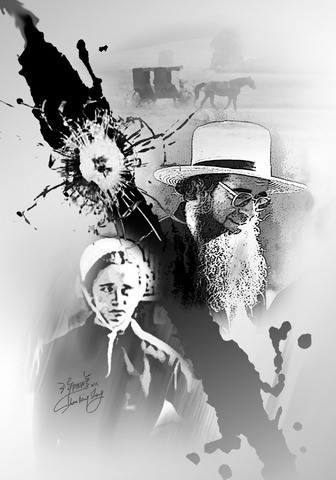In all the thousands of column inches of newsprint, amid all the hours of satellite television coverage devoted to the carnage in the schoolhouse in Nickel Mines, Pennsylvania, last week, it was the little details that stood out and gave you pause.
The fact that the police had to use vans to carry parents to hospital to be at the bedsides of their mortally wounded children because they refused to go by police helicopter. The scene of worried mothers timidly peeking over the heads of television cameramen filming a press conference near the school. While the pictures were being beamed instantly to Shanghai, they had to be there in person as they had no televisions to watch at home. The added sensitivity the authorities had identifying the bodies because there were no photographs to match against.
There is something about those snippets of life in the Amish community of Lancaster County that is strangely hard to deal with. On top of the sheer horror of the execution of five girls by a milk truck driver, there is bewilderment.

How can it be, in this digital age where news spreads at the speed of light through mobile phones, palmtops, satellite dishes and cable, that people living within a few kilometers of the tragedy were still learning by word of mouth of what Charles Carl Roberts IV had done hours after he had unloaded his 9mm semi-automatic handgun?
How can it be that he chose to inflict his revenge for some slight he suffered at the age of 12 on girls from a community whose very existence is the antithesis of the act he committed? The Amish are pacifist. At times of war they are conscientious objectors, prepared for civilian duties such as running fire departments but refusing anything military.
The community where Roberts exacted his revenge, 80km west of Philadelphia, has no police force and no guns. In the land of the National Rifle Association, that is quite something.
Anyone who can recall Witness -- the 1985 Harrison Ford thriller in which an eight-year-old Amish boy is the only witness to a murder -- will have a feeling for the setting of Lancaster County. Green rolling hills peppered with Holstein cattle, weather-beaten barns, unadorned buildings in washed-out colours, and the famous black horse-drawn buggies.
Add to that the "plain" dress, as they call it -- simple homemade clothes, buttons not zips, braces not belts, and the beards for men and the uncut hair for women pinned up under white lace hats like Victorian parlour maids. Around 25 percent of everyone in the community has the surname Stoltzfus. It all looks like what it is -- a community of agrarians largely set in aspic since the late 19th century.
Note the word largely.
Among the many misrepresentations of the Amish is that they are a group utterly impervious to modernity and shunning the world. In reality, they are the product of change, some of it dramatic.
The emergence of today's Amishes is a story of many schisms. Their parent faith, Mennonitism (or Anabaptism), was born of a split in Switzerland in 1525, when the Mennonites broke from the Protestant reform church in a dispute over infant baptism.
Later, in Switzerland in 1693, the Amish broke from the wider Mennonite community in a dispute over the shunning of those who had been excommunicated from the fold. The Amish emigrated to Pennsylvania around the 1730s to benefit from the Quaker William Penn's offer of protection for persecuted religions.
The Old Order of Amishes, the predominant group of approximately 30,000 people in Lancaster County from whom the murdered children originated, was then formed by another schism, in the late 19th century, when they broke from their fellow members in a dispute over the technological changes wrought by the industrial revolution. The Old Order was determined to take from technology only those elements that they could accommodate within their literal interpretation of the Bible, and that set them apart.
"It is easy to get it wrong about the Amish," says Peter Seibert, president of the Heritage Center of Lancaster County and a non-Amish.
"They are not about putting up walls to block out the modern world. What they are about is adapting their community to modernity in order to preserve its essential being as a simple agrarian society. They will pick and choose what they want from our world," Seibert added.
So they do not have electricity, not because electricity is in itself evil, but because of its impact within the home. They will not have TV, not because it is intrinsically heinous but because they do not want their children exposed to sexual and violent images. They travel by buggy to keep the community together and avoid the dissipating social influence of the motor car.
And modernity is there within the rolling hills of Lancaster County. They use horses and mules to work the fields, but look carefully and you will see at the back a hay bailer powered by petrol engine. They will not have phones in the house, but they will in the nearby shed where they run a woodworking business. They won't have electric gadgets, but they will have battery-powered cash registers and even laptops.
That's a subtlety lost in the peeping-Tom relationship that the "real world" has with the Amish. Every year, approximately 4 million tourists descend on Lancaster County -- many to gawk at the "freakin' aliens," -- as they have memorably been described. You can go on tours of the area that trace the plot of Witness, and buy quilts at up to US$1,000 a pop from the many Amish craft shops there.
"They can be quite disrespectful. Tourists walk right into Amish houses or schools assuming that they are there as an attraction. They have no sense that this is a living community that greatly prizes its privacy," Stephen Scott, a research fellow at Elizabethtown College, says.
He is himself from the related order of the River Brethren, which has gone a little further in its compromise with the modern.
"People think I'm an Amish when they look at me, but I do drive a car," he says.
The joke is, Scott points out, that the Amish are the ones to benefit. They may dislike being treated as zoo animals, but they also make a great deal of money out of the flow of tourists, which they use to support the community.
That duality was illustrated most vividly a couple of years ago when a reality TV company took the objectification of the Amish to new extremes by shooting Amish in the City, a show in which a group of Amish teenagers were taken out of their communities and flung into downtown Los Angeles.
Yet the Amish faith could accommodate even that. The teenagers were going through what is known as rumspringa in the German dialect still spoken by the Old Order. That means the "running around years," and it identifies the period between the end of school, at the age of 14, and the entry into the Church through baptism in one's late teens or early 20s, which is followed in quick succession by marriage and the start of a traditional Amish life.
In those five to eight years of freedom, the children are not officially members of the Church and so cannot be shunned or excommunicated.
As Seibert puts it: "They get the opportunity to see life from the other side of the fence. They change their plain clothes for Nike and Reebok, they drive around in SUVs without their parents' permission, they go into the big city."
The result, Seibert believes, is a community that -- unlike the Shakers, whose insistence on celibacy has been their undoing -- is thriving. More than 80 percent of the teenagers who move away from the community during rumspringa eventually come back to the fold. In stark contrast to the Shakers, the main pressure on the Amish now is population growth, coupled with the increasing lack of arable land on which they can subsist.
The keepers of the faith are not shrinking, but the reverse; they are spreading out to states such as Kentucky and Wisconsin, in which they have never before had a foothold.
None of which will be any comfort to the parents and neighbors of the five girls who died from Monday's shooting or the other five who remain critically ill. Any comfort will come from their faith itself.
Seibert puts it well: "In our post-post-modernist world, we have to find an explanation for everything that happens to us. But that is not how the Amish will see it. For them this is God's will, and that is all. Our world is all about the one. Theirs is all about the community before God, and about the better life they will lead after death. That is hard for us to comprehend, but that is how it is."
US President Donald Trump created some consternation in Taiwan last week when he told a news conference that a successful trade deal with China would help with “unification.” Although the People’s Republic of China has never ruled Taiwan, Trump’s language struck a raw nerve in Taiwan given his open siding with Russian President Vladimir Putin’s aggression seeking to “reunify” Ukraine and Russia. On earlier occasions, Trump has criticized Taiwan for “stealing” the US’ chip industry and for relying too much on the US for defense, ominously presaging a weakening of US support for Taiwan. However, further examination of Trump’s remarks in

As strategic tensions escalate across the vast Indo-Pacific region, Taiwan has emerged as more than a potential flashpoint. It is the fulcrum upon which the credibility of the evolving American-led strategy of integrated deterrence now rests. How the US and regional powers like Japan respond to Taiwan’s defense, and how credible the deterrent against Chinese aggression proves to be, will profoundly shape the Indo-Pacific security architecture for years to come. A successful defense of Taiwan through strengthened deterrence in the Indo-Pacific would enhance the credibility of the US-led alliance system and underpin America’s global preeminence, while a failure of integrated deterrence would
It is being said every second day: The ongoing recall campaign in Taiwan — where citizens are trying to collect enough signatures to trigger re-elections for a number of Chinese Nationalist Party (KMT) legislators — is orchestrated by the Democratic Progressive Party (DPP), or even President William Lai (賴清德) himself. The KMT makes the claim, and foreign media and analysts repeat it. However, they never show any proof — because there is not any. It is alarming how easily academics, journalists and experts toss around claims that amount to accusing a democratic government of conspiracy — without a shred of evidence. These
China on May 23, 1951, imposed the so-called “17-Point Agreement” to formally annex Tibet. In March, China in its 18th White Paper misleadingly said it laid “firm foundations for the region’s human rights cause.” The agreement is invalid in international law, because it was signed under threat. Ngapo Ngawang Jigme, head of the Tibetan delegation sent to China for peace negotiations, was not authorized to sign the agreement on behalf of the Tibetan government and the delegation was made to sign it under duress. After seven decades, Tibet remains intact and there is global outpouring of sympathy for Tibetans. This realization